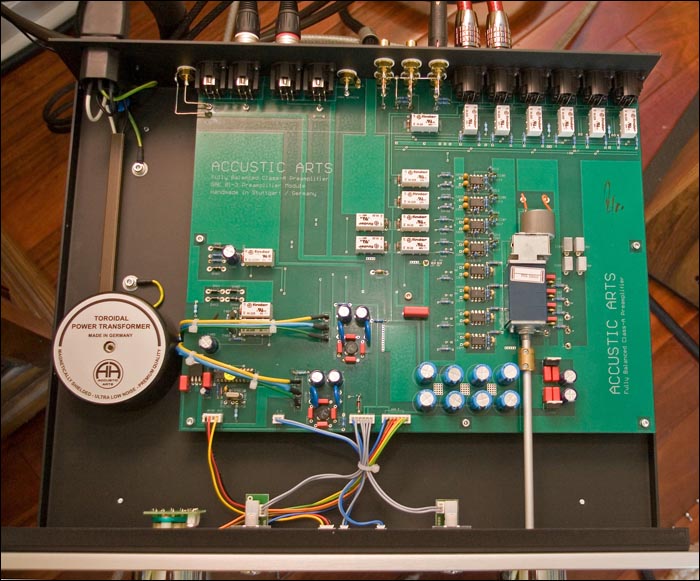|
This review page is supported in part by the sponsors whose ad banners are displayed below
|
|||||||||||||||
 |
|||||||||||||||
 |
|||||||||||||||
Once the damped cover is removed, one observes a nicely laid out fully balanced circuit. On this circuit board, simplicity and order rule quite in contrast to the more exuberant ways of NAT's Symmetrical. One sees the balanced volume control and its relay-activated motor (only engaged by remote trigger and otherwise turned off) plus the relay-switched inputs in the back. Circuit gain derives exclusively from op amps, i.e. selected premium Burr Brown OPA 627s and 2107s. At great despair to designers, the typical audiophile always associates a particular sonic outcome with a particular technology and op amps mostly have a bad rep in our circles. They are often associated with a harsh treble and hifi-ish attributes. |
|||||||||||||||
|
| |||||||||||||||
|
This image opens to full size in a new window |
|||||||||||||||
 |
|||||||||||||||
Accustic Arts begs to differ [as does Esoteric for that matter – Ed]. Whether due to parts choice or implementation I can't know but there isn't a trace of harshness here. If you insist on typical stereotypes, think solid-state class A amplifier and you won't be too far off the mark. Class A in fact is the mode of operation of the AA's output so there might be some truth to stereotypes after all. All in all this appears to be a classical solution and faultless implementation with very high-quality parts throughout for a rather promising start. It simply remained to be seen how it would translate into sonics. In a few words, rich, tonally dense, dynamic and weighty, with a sweet and golden treble, excellent but not extreme resolution and a midrange to die for. Think sensual belly dancer under a warm Tunisian sun. |
|||||||||||||||
 |
|||||||||||||||
In a few more words, my very first impression was actually not that good. The sound was rather flat and grayish but I always experiment with cables in the first few days to insure that I have the gear at its best for critical listening (this unit was delivered fully broken-in). Switching out my usual Zu Mother power cord for the Accustic Arts Ferrite II, then NAT power cord included by the US distributor, it quickly became obvious that the issue was not with the pre but rather, Zu's Mother. The addition of the Ferrite II instantly returned dynamics and tonal richness while the NAT added sparkle on top and tightness to the bottom. All further auditions were completed with the NAT which gave best results in my system. I'd recommend evaluating both cords though as each brought out a slightly different sonic emphasis. Your preference may vary. One thing is certain. Give the AA preamp a listen with various power cords. The most rewarding one in my case was neither the most expensive nor the cheapest. |
|||||||||||||||
|
|||||||||||||||
Once properly fitted with a power cord that enabled its true voice to shine, I also tested various interconnects to fine-tune the presentation. Here Zu's Varial continued to reign supreme despite the recent price hike. The far costlier Esoteric Mexcel is unquestionably better in every respect but its natural tendency towards richness and warmth was too much on the similarly voiced AA preamp so I happily reverted to the Varial. I also received a pair of Accustic Arts Silverline balanced interconnects ($1000/meter pair). Although the association was nice and provided a clean and open sound, I still preferred the cheaper Zu Varial for its greater resolution, speed and articulation. You won't go wrong with the AA Silverline but you'll go even less wrong with the Varial. |
|||||||||||||||
 |
|||||||||||||||
So outfitted, it was high time to switch into reviewer's mode and turn on the critical listening skills. And that's pretty much as far as that went. Listening with the Accustic Arts preamp was simply too much fun to bother with details. I eventually of course got to it but it took a lot of resolve to fire up the analytical brain. Connected to the Genesis GR360 driving a pair of FJ OMs with Esoteric's X03SE as the source, I was welcomed by such rich and enticing sonority that I simply listened. This preamplifier is not for the analytical, ultra-detailed, ultra dynamically inclined yet it should delight folks looking for tonal weight without sacrificing resolution and pace; who want sweet treble not shelved down but where the sweetness comes from low distortion and rich harmonics; and who value the human voice and want it reproduced in all its complexity and richness. Richness, there's that word again. I can't seem to get it out of my mind whenever I think about this preamplifier - rich like thick non-pasteurized cream or the scent of Jasmine in the southern Mediterranean; real and saturated like a spicy fragrance caught while passing through a Moroccan zouq which one unsuccessfully attempt to recreate with a little bottle purchased at the super market. |
|||||||||||||||
|
| |||||||||||||||
A lot of gear gives you the little bottle. The AA gives you the whiff. The C03, VRE-1 and NAT stick your head in the spice sack and for many, that may actually be too much. From that perspective, the AA is far easier to love and take advantage of. It gives a generous helping of reality without the associated pains that often accompany reality. |
|||||||||||||||
 |
|||||||||||||||
 |
 |
||||||||||||||
 |
|||||||||||||||